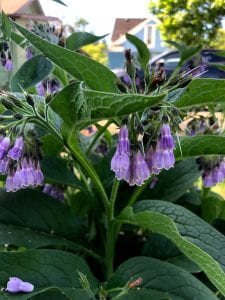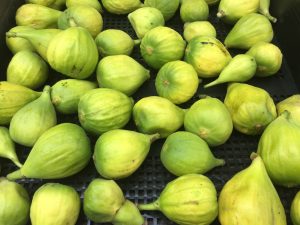It’s mid-May and comfrey is blooming in the garden, bringing our attention to this wonderful plant. The flowers are unexpected–sweet, bell shaped purple blooms drooping in umbles. Comfrey is a gem of the garden, providing many uses and benefits. At the Urban Farm, we like to add them to nearly every batch of compost because their leaves contain lots of nitrogen, phosphorus, AND potassium–the agricultural nutrient trifecta, NPK.
comfrey is blooming in the garden, bringing our attention to this wonderful plant. The flowers are unexpected–sweet, bell shaped purple blooms drooping in umbles. Comfrey is a gem of the garden, providing many uses and benefits. At the Urban Farm, we like to add them to nearly every batch of compost because their leaves contain lots of nitrogen, phosphorus, AND potassium–the agricultural nutrient trifecta, NPK.
NPK are the primary elements of every fertilizer. They are the basis of what you need to grow plants. You can make your own fertilizer out of just comfrey leaves and water. All you have to do is fill a bucket with about a quart of comfrey leaves and 4-5 gallons of water. Let it sit for a month or so, and you’ll have a stinky brown liquid to fertilize your crops. You can add comfrey with any method of adding nutrients to the soil/plants, like mulching, leaf mould heaps, or simply the bottom of a pot or hole you’re growing vegetables in.
Comfrey is a wonderful plant to have growing in every garden. The nutrient-dense, prolific perennial not only acts as fert ilizer but also attracts pollinators with their sweet purple blooms and has medicinal properties. Comfrey has soothing, anti-inflammatory properties and can be made into an herbal salve for skin conditions like dryness, rashes, and abrasions. It grows back rapidly after each harvest, making it a great plant to use throughout the season. Grow comfrey to serve a multitude of needs and add vibrant health to your garden!
ilizer but also attracts pollinators with their sweet purple blooms and has medicinal properties. Comfrey has soothing, anti-inflammatory properties and can be made into an herbal salve for skin conditions like dryness, rashes, and abrasions. It grows back rapidly after each harvest, making it a great plant to use throughout the season. Grow comfrey to serve a multitude of needs and add vibrant health to your garden!
















